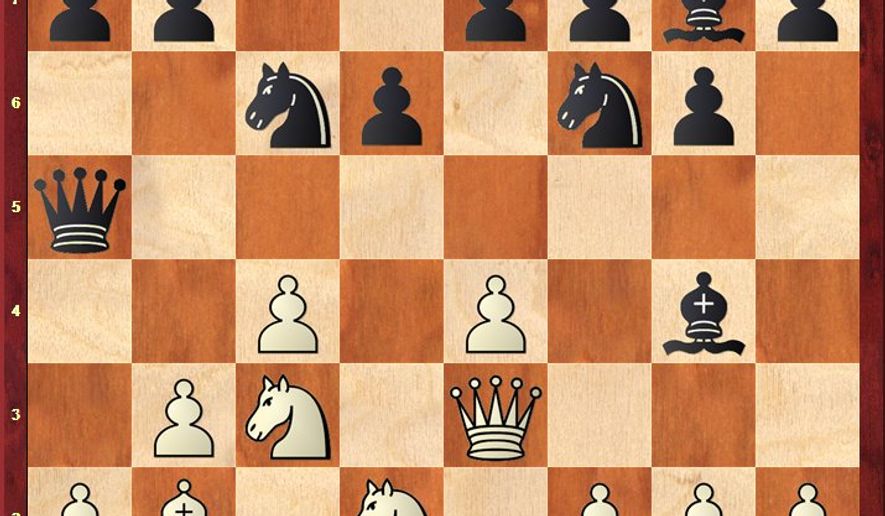For such an ancient and venerable game, chess offers some surprisingly direct links to its distant past.
Consider: The great American GM Arthur Bisguier, the 85-year-old “Dean of American Chess,” in 1950 played a 15-move draw against the legendary Russian-born Polish-French star Savielly Tartakower, then 63. Tartakower in his youth had played such 19th century immortals as England’s Joseph Henry Blackburne, who crossed swords ten times over the board with the first recognized modern world champion, Germany’s Adolf Anderssen.
Play a casual game with Bisguier, in other words, and you’re just three degrees of chess separation from the player who lost the famous match to Paul Morphy three years before the start of the Civil War.
What sparked these thoughts was the arrival in the mailbox of “Bent Larsen’s Best Games: Fighting Chess with the Great Dane.” A colorful attacking player, Larsen, who died just four years ago, was considered the best chess player in the West in the era of Soviet chess hegemony before a certain Bobby Fischer burst on the scene.
This biographical anthology includes some of Larsen’s greatest wins, over players such as Fischer, Smyslov, Petrosian, Karpov and Spassky — world champions all. But what caught our eye was an early game by the then-19-year-old Dane at the 1954 Amsterdam Olympiad. His opponent: Russian-born GM Ossip Bernstein, who started competing in top-level tournaments in 1902 and played in such epic events at the 1914 St. Petersburg Tournament.
Bernstein, playing top board for France, was celebrating his 72nd birthday the day the game was played but, Larsen noted, “he wouldn’t be receiving a birthday present from me.”
It’s the young buck who snookers the savvy vet in the amusing early tactic that essentially decides the game. In a rare Sicilian sideline, Bernstein’s sense of danger deserts him after 9. Nd2 Nc6 10. Qe3?? (Qd3 keeps things equal), as the spacing of White’s king, queen and rook allow Black a diabolical tactic.
Thus 10…Nb4! (at first this seems a waste of time, but Larsen knows what he’s about) 11. Rc1 (see diagram) Nxa2!!, when White suddenly realized his intended 12. Ra1 runs into 12…Nb4! 13. Rxa5 Nc2 mate. When the young Dane returned to his board after a stroll around the tournament hall, “Bernstein suddenly raised his large head and said, ’Sehr schon gespielt’ (“Very well played”) before continuing with his deliberations,” Larson wrote.
Black must still take care to extract his queen (15…h5! parries the threatened 16. Bd3 with 16…Bh6!), but a second petite combination gives Larsen a decisive edge: 18. Bb4 Bf8 19. Nb1? (19. h3 and the development of his kingside gives White a fighting chance at a draw; the loose White bishop on b4 provides Black another opening) Nxe4! 20. Qxe4 d5! (much better than the lazy 20…Bf5?! 21. Qd5 Bxb1 22. Be2 Bc2 23. 0-0, and White has real counterplay despite his two-pawn deficit) 21. Rxd5 Bxb4+ 22. Nd2 0-0, “and White’s pinned knight and inability to castle make his position hopeless,” Larsen writes.
The d-file pressure soon costs White a full piece, and, in the final position, White forfeited on time in a doomed position.
—-
Larsen would unfortunately become remembered by many as the second of Fischer’s epic 6-0 Candidates’ shutout victims in the American’s drive to the 1972 Reykjavik match with Spassky.
Bernstein, interestingly, also played a key supporting role in some of the game’s greatest moments. His loss to eventual world champion Jose Raoul Capablanca at a Moscow tournament in 1911, featuring a stellar back-rank mate tactic, is one of the Cuban’s most anthologized games.
And though he finished sixth at the great St. Petersburg event in 1914 — only the top five advanced to the finals — Bernstein was critical to how the tournament played out. Bernstein dealt reigning world champ Emanuel Lasker his only loss of the preliminary rounds, setting up the famous Lasker-Capablanca clash in the finals, where the wily champ came from behind to defeat the man who would soon claim his crown.
Against Bernstein, Lasker easily equalized from the Black side of a solid Ruy Lopez Steinitz, and by 28. axb3 Ra2 29. f3 Ng5 Black actually has the better of the play. But an uncharacteristic calculating error undoes the champion.
Black blunders on 35. Nd4 Qh2? (Qg3! was the move, as after 36. Nf5 [Nxe6?? Ra2 37. Re2 Ra1+ leads to mate] Qxg2+! 37. Kxg2 Nf4+ 38. Kg3 Nxd3 39. Rd1 Ne5 40. Re1 Ng6 41. h4 h5 42. Ne7+ Nxe7 43. Rxe7, Black has the better ending, one that Lasker, a superlative endgame player, might well have converted) 36. Nxe6 Ra2 37. Re2 Ra1+ 38. Kf2 fxe6 (Black apparently thought 39. Qg1 was mate here, forgetting the White king can escape via g3) 39. Qg6, and White wins a critical pawn.
Handed a gift, Bernstein makes the most of it, giving Lasker no chances to work his way back into the game. He forces a queen trade, and in the final position, the Black king is in a box while the White king is free to roam and pick off the c-pawn; Lasker resigned.
—-
End of an era? “This is the final chess column to run in The New York Times” was the terse last sentence of Dylan Loeb McClain’s weekly column in the newspaper Sunday. With legendary U.S. stars I.A. Horowitz and GM Robert Byrne among those who have handled the editorial duties, the paper has run the chess column continuously since 1962.
A spokeswoman confirmed to the Poynter.org website that The Times was “considering eliminating the chess column in order to keep freelance costs in line.” But, she added, “a final decision for the column (on all platforms) has not been made yet.”
• David R. Sands can be reached at 202/636-3178 or by email at dsands@washingtontimes.com.
• David R. Sands can be reached at dsands@washingtontimes.com.




Please read our comment policy before commenting.